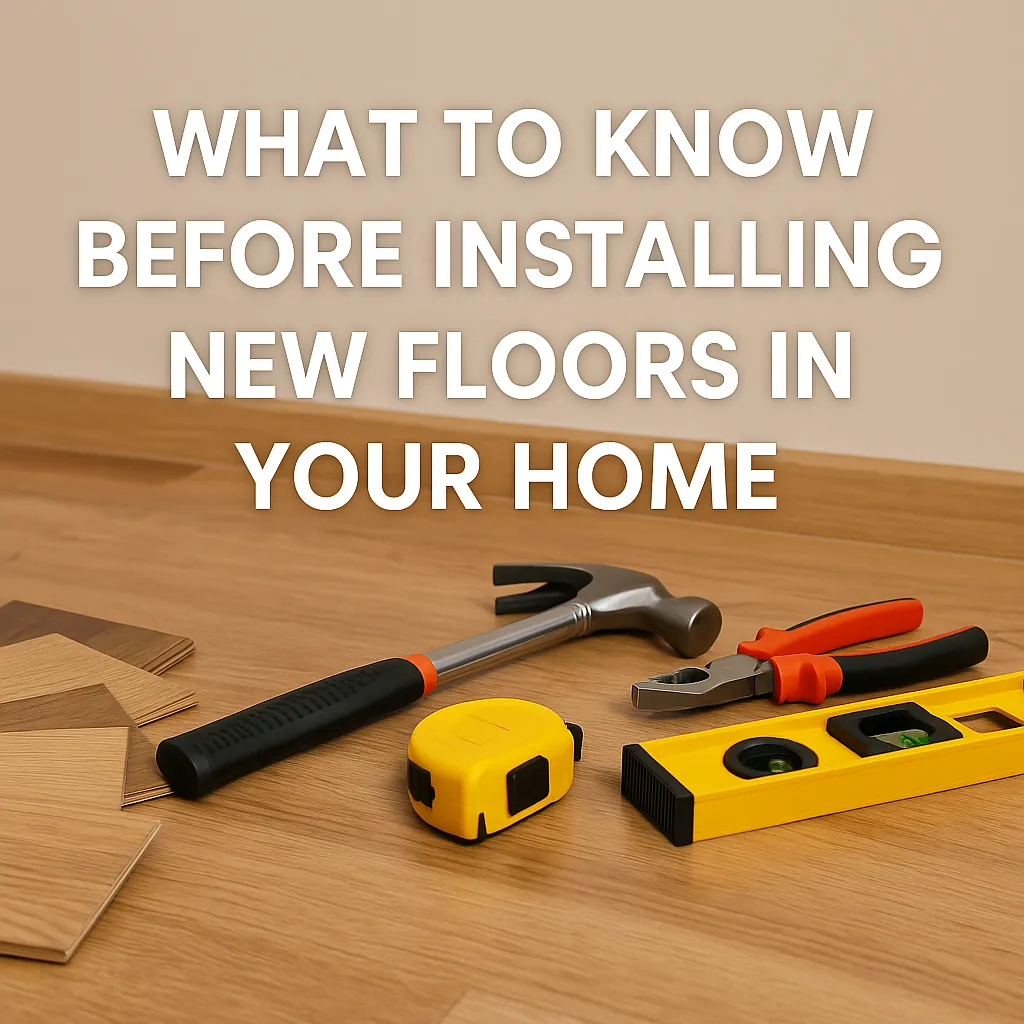What to Know Before Installing New Floors in Your Home

What to Know Before Installing New Floors in Your Home
Installing new flooring can completely transform the look and feel of your home, adding style, comfort, and even increasing property value. However, before jumping into a flooring project, there are several key factors to consider. Understanding your needs, budget, space, and lifestyle will help you make the right decisions and avoid costly mistakes. Here’s what you should know before installing new floors in your home.
1. Assess Your Lifestyle and Needs
Your daily habits and household traffic greatly influence the type of flooring that’s best for you. Ask yourself:
- Do you have pets or kids?
- Is the area exposed to a lot of foot traffic?
- Do you often deal with spills or moisture?
For example, luxury vinyl, tile, and laminate are great for high-traffic areas, while hardwood and carpet work well in low-traffic, cozy spaces. Durability and ease of cleaning should be top priorities in busy homes.
2. Understand Flooring Types and Materials
There are various flooring options, each with its pros and cons:
- Hardwood: Timeless and elegant, but prone to scratches and water damage. Ideal for living rooms and bedrooms.
- Engineered Wood: Offers the look of hardwood but is more moisture-resistant and stable.
- Laminate: Affordable and easy to maintain, with a wide range of styles. Not waterproof but resistant to scratches.
- Vinyl Plank: Waterproof and durable, ideal for kitchens, bathrooms, and basements.
- Ceramic or Porcelain Tile: Extremely durable and waterproof, perfect for wet areas.
- Carpet: Soft and warm, great for bedrooms, but can trap dust and allergens.
Your choice should depend on the room’s function, desired appearance, and maintenance level you’re comfortable with.
3. Set a Realistic Budget
Flooring costs go beyond the price per square meter. Your total budget should include:
- Cost of materials
- Underlayment or padding
- Installation charges
- Floor preparation (removing old flooring, leveling the surface)
- Additional materials like trims, transitions, or adhesives
Make sure to get several quotes and understand what’s included. For instance, hardwood flooring can cost more upfront but adds long-term value, while vinyl is more budget-friendly.
4. Consider Your Subfloor and Existing Flooring
The condition of your subfloor impacts installation. Uneven or damaged subfloors may need to be repaired or replaced. Additionally, certain floors like tile or hardwood may need to be removed before new flooring can be installed.
In some cases, you can install new flooring over existing floors, such as placing laminate over tile. Always check the manufacturer’s guidelines and consult with a professional if you’re unsure.
5. Climate and Moisture Matter
Your home’s climate—especially humidity levels—affects flooring choice:
- Wood floors can expand or contract with humidity changes, making them unsuitable for basements or coastal regions unless properly treated.
- Vinyl, tile, and concrete flooring perform better in humid or moisture-prone areas.
- Moisture barriers may also be required, especially for ground-level or basement installations.
6. Plan for Maintenance and Longevity
Different flooring types require different care routines. Consider:
- Is regular sweeping and occasional mopping enough?
- Will it need refinishing or resealing?
- Is it stain- or scratch-resistant?
Choose a floor that suits your willingness to maintain it. For instance, tile is virtually maintenance-free, while wood may need refinishing every few years.
7. Think About Style and Aesthetics
Flooring is a visual foundation of your home décor. Consider:
- Color: Light floors make rooms feel bigger and brighter, while dark tones add coziness and contrast.
- Texture: Smooth, matte, distressed, or glossy—choose what complements your interior.
- Pattern and Plank Size: Wide planks can make small rooms look larger, while herringbone or chevron patterns add luxury and sophistication.
Try samples in your space at different times of the day to see how they look under various lighting conditions.
8. Professional vs. DIY Installation
Some floors are DIY-friendly, like laminate and click-lock vinyl, while others like tile and hardwood require professional expertise. Consider:
- Do you have the tools and time?
- What’s the risk of making mistakes?
While DIY may save on labor, poor installation can reduce the lifespan and beauty of your floors.
9. Timeline and Disruption
Flooring projects can be disruptive. Estimate how long it will take and prepare accordingly:
- Will you need to move furniture?
- Will any rooms be unusable for a few days?
- Do you need to stay elsewhere during the installation?
Planning in advance can minimize stress and delays.
10. Warranty and After-Sales Support
Check product warranties, especially for long-term investment materials like hardwood or vinyl plank. Understand what’s covered:
- Wear and tear?
- Water damage?
- Installation issues?
Ensure you buy from reputable suppliers and certified installers to validate any warranties.
Installing new flooring is a big decision that affects your home’s comfort, functionality, and value. By evaluating your lifestyle, budget, climate, and design preferences, you’ll be better equipped to make an informed choice. Whether you go for elegant hardwood, modern vinyl, or cozy carpet, the key is proper planning and expert guidance when needed.
Vinyl plank and ceramic tile are among the most durable options for high-traffic areas. They resist scratches, moisture, and wear, making them ideal for kitchens, hallways, and entryways.
In many cases, yes. Certain flooring types like laminate or vinyl can be installed over tile or hardwood, provided the surface is level and clean. Always follow the manufacturer's guidelines.
Scratch-resistant and waterproof options like vinyl plank, laminate, or tile are best for homes with pets. Avoid softwood or carpet that can trap fur and odors.
It depends on the type of flooring and room size. A single room can take 1–3 days, while whole-home projects may take a week or more. Subfloor repairs and acclimation periods can add time.

We Operate In Dubai.
We look forward to working with you and creating a stunning home that you and your family will love for years to come!



